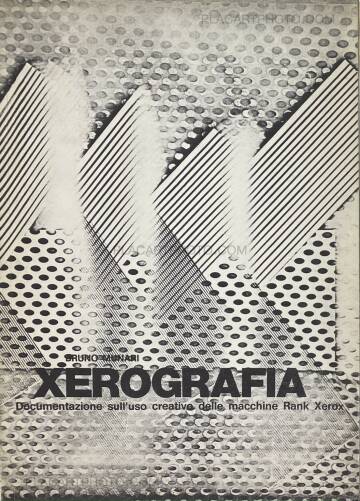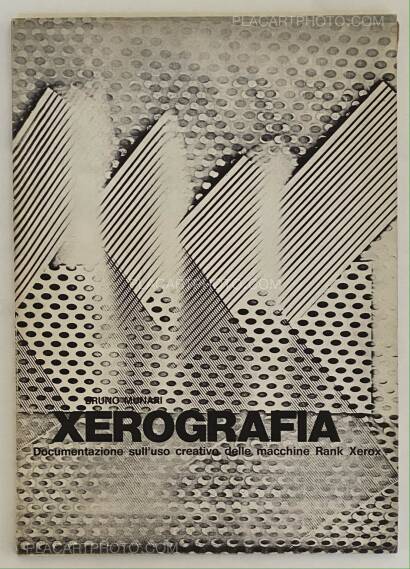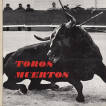XEROGRAFIA

Bruno Munari
XEROGRAFIA
Photographs: Bruno Munari
Publisher: self published
52 pages
Year: 1970
Comments: Softcover, numerous b&w illustrations, preserved in very good condition! Rare artist's book!
Book produced on the occasion of the XXXV Venice International Art Biennale, 1970. Munari was one of the first artists to use these machines creatively. "The results of the most advanced scientific and technological research, although generally understood with very different functions, can offer unexpected means to the creative operation, and open up a rich and fascinating discourse in the area of artistic research".
Focusing on Munari’s experiments with the Xerox 914 Machine, which began in 1963 and would continue throughout his entire career, the presentation brings a selection of works documented in his seminal book “Xerografia: Documentazione sull’uso creativo delle macchine Rank Xerox (Xerography: Documentation of the creative use of the machine Rank Xerox)”. Published in conjunction with Munari’s participation in the 1970 Venice Biennale, to which Munari contributed a Xerox machine to an experimental laboratory within the Biennale, the book provides instructions on the many ways to subvert the commercial machine’s function to create original images and artworks. Ranging from abstract to figurative, Munari’s Xerox works distort the original subject as he moved images across the devices surface for the duration of the scanning process.
In his prolific, 70-year career, Bruno Munari became known for various contributions to art, industrial design, film, architecture, art theory, and technology—including an early model of the portable slide-projector. He liked to (falsely) claim that his name meant “to make something out of nothing” in Japanese. Munari’s principles and beliefs were built upon his early involvement in the Futurist movement, which he joined at the age of 19 using the pseudonym “Bum.” During the 1930s, Munari began to move towards Constructivism, particularly with his kinetic sculptures, Useless Machines (begun 1933), meant to transform or complicate their surrounding environments. Throughout his career, Munari was captivated by both a sense of whimsy and the manipulation of artificial light. After World War II, Munari also developed radical innovation in graphics, typography, and book publishing, through the latter creating pieces he would call Useless Books.












more books tagged »Artist's book« | >> see all
-
La nostalgie de l'infini (SIGNED AND NUMBERED, edt of 100)
by Veronica Mecchia
Euro 70 -
PERSONA (NUMBERED, edt of 50)
by Laura Rodari
Euro 60 -
TYO2 (ONLY 35 COPIES - SIGNED)
by Antony Cairns
sold -
Conversations with trees (EDT OF 6)
by Kathleen Alisch
Euro 1800 -
Every building on the Sunset Strip (1st With the extra flap)
by Ed Ruscha
Euro 2500 -
Spark (Signed Ltd edt of 10)
by Kinzazadan [Arata Fukuda]
sold
more books tagged »abstract« | >> see all
-
Film (Signed)
by Daisuke Yokota
sold -
LA NUMÉRISATION TUE L'IMAGE (Edt of 50)
by Morgane Bartoli
sold -
07) 41.667 (Signed and numbered)
by Tiane Doan na Champassak
sold -
FOUR WEELS TRACES (Signed)
by Sergej Vutuc
sold -
Sediment (Signed and Numbered to 80)
by Daisuke Yokota
sold -
Photography 写真 (Last copy, seald copy, blue cover)
by Koji Kitagawa
sold
more books tagged »xerox« | >> see all
-
Boyhood (Edt of 150)
by Joe Cruz
sold -
Raised by Wolves (BOOTLEG EDITION)
by Jim Goldberg
sold -
SET OF LINGER (SIGNED) + TEIKAI + IMMERSE (SIGNED)
by Daisuke Yokota
sold -
Ozone (Signed)
by Else Bedoux
sold -
Kingdom I-IV (Signed)
by Chiara de Franciscis
sold -
Nantouryou 1969 -1971
by Kenshichi Heshiki
sold
more books tagged »italian« | >> see all
-
Gli Esclusi : Fotoreportage da un'istituzione totale
by Luciano d'Alessandro
sold -
STUDIO
by Paolo Roversi
sold -
Archivio (Signed)
by Bruno Locci
Euro 400 -
Megalopolis: Los Angeles, Mexico, San Paolo
by Paolo Gasparini
sold -
Les Plages du Var
by Massimo Vitali
sold -
Pensare per immagini
by Luigi Ghirri
sold
Books from the Virtual Bookshelf josefchladek.com





























;jpg)

 Facebook
Facebook Instagram
Instagram